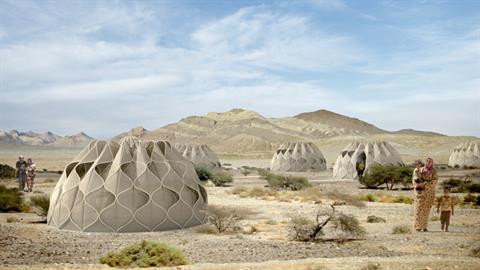BEIRUT: Abeer Seikaly saw a tent and, invoking nomadic lifestyles of the past, re-envisioned its structure as a self-sustaining shelter, not only achieving its primary function of housing refugees, but also providing the point from which their social interactions can be recreated in a new environment.
Her project, “Weaving a Home” re-examines the traditional architecture of tent shelters, creating a fabric that both expands and contracts according to weather conditions, while providing utilities to ensure the provision of heat, running water, electricity and storage. The result is a collapsible, mobile solar-powered refugee tent. The design project garnered her a prize in last year’s Lexus Design Award, with a prototype and patent in the pipeline.
Seikaly submitted the project to the design contest because its theme of “motion” resonated with her.
She has been experimenting with the relationship between structure and fabric for years, while also exploring abstract concepts like motion, time, self-sufficiency and nature in her work.
“When I talk about motion, I am talking about physical motion, but I am also talking about it in a non-physical way,” she told The Daily Star. “The work I do has to do with movement, patterns, light, and I am mostly interested in the type of experience that a space or an object would give to its viewer, occupant and so on.”
The experience of the “object” in Seikaly’s design work is also related to movement.
“Time describes movement,” she continues, describing the theoretical underpinnings of her work. “This is really the main focus, the way things change over time and shift through memory and current experience, and how current experience unfolds with the things we interact with.”
Seikaly’s design concept is deeply rooted in nature, and her work employs principles that she perceives as existing already in the environment. “Whatever is created cannot be detached from the dimension in which it interacts,” she said.
The idea for “Weaving a Home” was the unexpected result of designing luxury retail stores, something Seikaly, who is based in Amman, has been doing since 2005.
“I had to look at many aspects. It was like a dance of some sort. You have to involve the five senses, and engage buyers in many different ways: Visually, sensually, aurally,” she said.
Her experience of the fashion world paved the way for her to use fabric in ingenious and integrated ways, a quality that stands out in her design concept for the tent shelter.
“This was something I saw in existing tents, where … fabric is draped over the structure, but it was never conceived of or thought out as a holistic system,” she said. “I think this was my point of departure.”
She began by looking at the physical aspect of a tent and poor conditions of most refugee camps. Jordan hosts over 500,000 Syrian refugees, most of whom live in overcrowded camps. In Lebanon nearly 1 million Syrian refugees are registered, many living in improvised shelters.
Seikaly also invoked the past in her research for the project.
“There is a very direct reference … in the way nomadic tribes used to live and travel, and these [tents] were their only homes,” she said.
“I tried to look at the physical aspects of a tent that could be inspired by traditional weaving and how to reference old traditional techniques and reinterpret them in our world in a way that addresses contemporary needs.”
Seikaly said the outer solar-powered fabric of the tent should blur the line between fabric and structure and is heavily inspired by weaving techniques unearthed during the research phase. Her design sketches detail how it absorbs solar energy and converts it into power, while the inner fabric features pockets for storage. A storage tank at the apex of the tent supplies water for showers, with a drainage system to avoid flooding.
The tent opens up for the warm summer months and can be clumped down for the colder winter season.
Seikaly’s project will likely require some tweaking before it can be a bona fide product, though she hopes it will one day be the standard shelter for the displaced.
Already, she has been flooded with emails from individuals who live in dire conditions, inquiring about the feasibility of her design, and from engineers interested in its structural integrity. She admits the project will have to be a collaborative one. For now, it represents an example of how inventive design can complement and facilitate humanitarian assistance.
“Design is supposed to give form to a gap in people’s needs,” Seikaly writes in her design brief for the project. “This lightweight, mobile, structural fabric could potentially close the gap between need and desire as people metaphorically weave their lives back together, physically weaving their built environment into a place both new and familiar, transient and rooted, private and connected.”
The Daily Star






